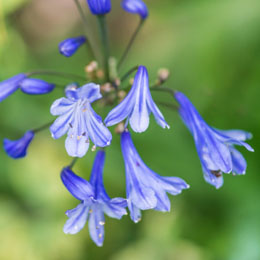Agapanthus plants produce clusters of violet or blue flowers, right from late spring to summer. Though these plants are perennial, digging up the fleshy rhizomes before the arrival of cold winter months is crucial to overwinter them. Read on to know more.

Agapanthus is a perennial flowering plant that blooms in shades of white, blue and purple. Indigenous to South Africa, agapanthus plants are known by different names, like African Lily, African Blue Lily and Lily of the Nile. Today, agapanthus is a plant of choice for flower lovers all across the globe. The beautiful showy flowers that come in round clusters are nothing less than a show stopper for every avid gardener. A single cluster measures about 6-8 inches across and comprises more than 100 small, lily like tubular florets.
Growing Agapanthus
Agapanthus propagation is done by separating the tuberous root clumps after the flowering season is over. As cold winter arrives, the fleshy rhizomes are dug from flower garden for overwintering purpose. Regarding how to divide agapanthus plants, the leafy part is first trimmed above the ground level. Using a spade or other suitable garden tool, loosen the soil away from the stem and several inches deep into the soil. Then, lift the stem portion carefully with the help of a garden trowel. Separate the rhizomes into smaller clumps, making sure that each clump has a sprout and healthy roots.
In hot climatic areas, planting of agapanthus is done immediately after dividing the rhizomes. For colder regions, wait till spring season, when the temperature is favorable for growing these perennial flowers. Agapanthus plants grow best in fertile, moist and well-drained soil types. Select sunlit areas in the yard, and dig planting holes (2-inch deep and 4-inch wide). Place one rhizome section in each of the hole, and cover the root portion with soil. In case of container gardening, select a 12-inch pot, filled with moderate fertile potting media till the pot neck, and plant agapanthus in the same way as mentioned above.
Caring for Agapanthus
Even though agapanthus plant blooms all summer, you need to follow specific care tips to induce heavy bloom production. Those potted plants require close monitoring, basically in the first few weeks of plantation. This is because the soil gets dry very quickly, which agapanthus cannot tolerate. Considering that you have grown agapanthus bulbs correctly with 4-5 inch space in between, the general perennial plant care instructions for agapanthus include the following.
- Deeply water the newly-planted agapanthus at regular intervals, until they get established to the new site. Within a few weeks, you will notice sprouting of new leaves and development of root system.
- Keep a watch over your potted plants, and if required irrigate them every alternate day. Providing sufficient water is all that matters in promoting new shoot growth in potted plants.
- During spring and summer, when the environment air becomes dry and temperature remains high, provide supplemental water to the plants. Eventually, reduce watering frequency in fall and winter months.
- Depending upon which agapanthus species you have planted, it will develop flowering buds in the last few weeks of spring or early summer. To maintain a clean look, you can remove drying foliage from the base.
- The flowers are borne in umbel inflorescence, having a stalk of about 2-4 feet. If you are fond of keeping cut flowers, you can cut the flowering stalk at a desired length. But, make sure you use a sharp cutter, or else it may injure the plants.
After the flowering season, probably in the beginning of the fall season, cut off the spent flower stalk, but retain the leaves. In case of very cold areas, wintering agapanthus plants is necessary. For potted plants, bring them indoors to avoid the damaging effects of frost. When maintained in favorable growing conditions, these plants produce maximum blooms in summer. Grow these hardy plants with simple gardening tips and enjoy blue colored blooms from late spring throughout the summer season.






 Agapanthus is a perennial flowering plant that blooms in shades of white, blue and purple. Indigenous to South Africa, agapanthus plants are known by different names, like African Lily, African Blue Lily and Lily of the Nile. Today, agapanthus is a plant of choice for flower lovers all across the globe. The beautiful showy flowers that come in round clusters are nothing less than a show stopper for every avid gardener. A single cluster measures about 6-8 inches across and comprises more than 100 small, lily like tubular florets.
Agapanthus is a perennial flowering plant that blooms in shades of white, blue and purple. Indigenous to South Africa, agapanthus plants are known by different names, like African Lily, African Blue Lily and Lily of the Nile. Today, agapanthus is a plant of choice for flower lovers all across the globe. The beautiful showy flowers that come in round clusters are nothing less than a show stopper for every avid gardener. A single cluster measures about 6-8 inches across and comprises more than 100 small, lily like tubular florets.